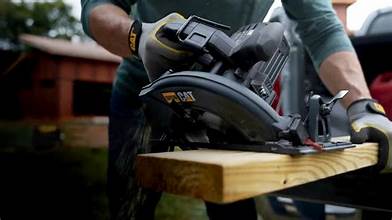Exploring the world of top-rated power tools for construction work unveils a realm of innovation and efficiency. From essential tools to safety measures, this guide delves into the intricacies of choosing, using, and maintaining power tools in construction projects.
Types of top-rated power tools for construction work
Power tools are essential for any construction work, providing efficiency and accuracy in completing tasks. Here are five top-rated power tools commonly used in construction:
Circular Saw
A circular saw is a versatile tool used for making straight cuts in wood, metal, or plastic. Its portability and ability to adjust cutting depth make it ideal for various construction tasks such as framing, roofing, and flooring installation.
Drill
A drill is a must-have tool for creating holes in different materials like wood, metal, and concrete. It can also be used for driving screws and fasteners, making it essential for tasks like hanging shelves, assembling furniture, and installing fixtures.
Impact Driver
An impact driver is a powerful tool designed for driving screws and bolts quickly and efficiently. Its high torque and impact mechanism make it suitable for heavy-duty tasks like building decks, framing, and installing cabinetry.
Rotary Hammer
A rotary hammer is a specialized tool for drilling into tough materials like concrete, masonry, and stone. Its hammering action and rotary motion make it perfect for tasks such as drilling anchor holes, setting concrete screws, and chiseling.
Reciprocating Saw
A reciprocating saw is ideal for cutting through a variety of materials like wood, metal, and PVC pipe. Its back-and-forth motion allows for efficient cutting in tight spaces, making it useful for demolition, remodeling, and plumbing work.
Factors to consider when choosing power tools for construction work
When selecting power tools for construction work, several factors must be taken into consideration to ensure optimal performance, efficiency, and safety on the job site.
Power Source: Corded vs. Cordless
The choice between corded and cordless power tools is crucial in construction work. Corded tools provide consistent power output but may limit mobility due to the need for an electrical outlet. On the other hand, cordless tools offer greater flexibility and portability but require recharging, which can interrupt workflow.
Consider the specific needs of the project and the availability of power sources on-site when deciding between corded and cordless options.
Ergonomics and Weight
The ergonomics and weight of a power tool can significantly impact its usability and efficiency. Tools that are comfortable to hold and operate reduce the risk of fatigue and injury, allowing workers to focus on the task at hand. Lightweight tools are easier to maneuver in tight spaces and overhead applications, increasing productivity and reducing strain on the user's body.
Prioritize tools that are ergonomically designed and appropriately weighted for the job to enhance overall performance.
Durability and Maintenance
Different power tool brands vary in terms of durability and maintenance requirements. Some brands are known for their robust construction and long lifespan, while others may require frequent repairs or replacements. Investing in high-quality, reputable brands can save time and money in the long run by reducing downtime and ensuring reliable performance.
Consider the durability and maintenance needs of each brand when selecting power tools for construction work to maximize efficiency and longevity.
Safety measures and precautions when using power tools in construction
When it comes to using power tools in construction, safety should always be a top priority. By following proper safety measures and precautions, workers can minimize the risk of accidents and injuries on the job.
Common safety hazards associated with power tools on construction sites
- Electric shock: Always use tools with grounded plugs and avoid using damaged cords.
- Flying debris: Wear safety goggles to protect your eyes from debris generated by power tools.
- Lacerations: Avoid wearing loose clothing or jewelry that could get caught in power tools
.
- Hearing damage: Use ear protection when operating loud power tools to prevent hearing loss.
Proper safety gear and equipment necessary when operating power tools
- Safety goggles: Protect your eyes from debris and flying particles.
- Ear protection: Prevent hearing damage from loud power tools.
- Gloves: Ensure a secure grip and protect your hands from cuts and abrasions.
- Hard hat: Protect your head from falling objects or accidental impacts.
Importance of regular maintenance and inspection of power tools for safety
Regular maintenance and inspection of power tools are crucial to ensuring their safe operation. By checking for wear and tear, damaged cords, or malfunctioning parts, workers can prevent accidents and prolong the lifespan of the tools. It is essential to follow the manufacturer's guidelines for maintenance and to promptly repair or replace any faulty equipment to maintain a safe working environment.
Tips for maximizing the efficiency and longevity of power tools in construction work
Proper maintenance and care of power tools are essential to ensure their efficiency and longevity in construction work. By following these tips, you can maximize the performance of your tools and prevent unnecessary downtime.
Techniques for proper storage and care of power tools when not in use
- Always clean your power tools after each use to prevent dust and debris buildup, which can affect their performance.
- Store your power tools in a dry and secure place to avoid exposure to moisture, which can lead to rust and corrosion.
- Use protective cases or toolboxes to keep your power tools organized and protected from damage when not in use.
- Regularly inspect your power tools for any signs of wear and tear, and address any issues promptly to prevent further damage.
Significance of using the correct accessories and attachments for each power tool
- Using the right accessories and attachments for your power tools can enhance their performance and efficiency for specific tasks.
- Incorrect accessories or attachments can not only reduce the effectiveness of the tool but also pose safety risks to the user and the work environment.
- Refer to the manufacturer's guidelines and recommendations for the appropriate accessories and attachments to use with each power tool.
- Investing in high-quality accessories and attachments can improve the overall functionality and lifespan of your power tools.
Insights on how to troubleshoot common issues with power tools to prevent downtime
- Regularly inspect your power tools for any signs of malfunction or unusual noises during operation, and address these issues promptly.
- Refer to the user manual or online resources for troubleshooting tips and common solutions to issues that may arise with your power tools.
- Keep your power tools properly lubricated and maintained to prevent overheating and excessive wear on internal components.
- Seek professional help or contact the manufacturer for assistance with complex technical issues that you may encounter with your power tools.
Summary
As we conclude this journey through top-rated power tools for construction work, remember that the right tools, used safely and maintained properly, can make all the difference in the efficiency and longevity of your projects. Equip yourself with knowledge and skill to excel in your construction endeavors.
FAQ Compilation
What are some common safety hazards associated with power tools in construction?
Common safety hazards include electric shock, cuts, burns, and falls. It's crucial to follow safety protocols and wear appropriate gear to prevent accidents.
How can I maximize the efficiency of power tools in construction work?
Proper storage, regular maintenance, and using the correct accessories are key to maximizing efficiency and longevity of power tools. Additionally, troubleshooting common issues promptly can prevent downtime.
What factors should I consider when choosing power tools for construction work?
You should consider the power source (corded vs. cordless), ergonomics, weight, durability, and maintenance requirements of different power tool brands. Each factor plays a role in the tool's usability and performance.







